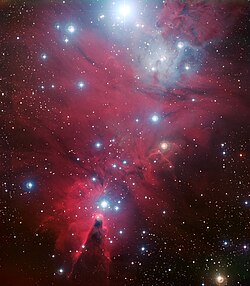S Monocerotis lies in NGC 2264 | |
| Observation data Epoch J2000 Equinox J2000 | |
|---|---|
| Constellation | Monoceros |
| A | |
| Right ascension | 06h 40m 58.656s [1] |
| Declination | +09° 53′ 44.71″ [1] |
| Apparent magnitude (V) | 4.66 [2] (4.62 - 4.68 [3] ) + 5.90 [2] |
| B | |
| Right ascension | 06h 40m 58.566s [1] |
| Declination | +09° 53′ 42.20″ [1] |
| Apparent magnitude (V) | 7.830 [1] |
| Characteristics | |
| Spectral type | O7V((f))zvar [4] + O9.5Vn [5] + B2V [6] |
| U−B color index | −1.034 [7] |
| B−V color index | −0.261 [7] |
| Variable type | Ia [3] |
| Astrometry | |
| A | |
| Radial velocity (Rv) | 22.00 [8] km/s |
| Proper motion (μ) | RA: −2.61 [9] mas/yr Dec.: −1.61 [9] mas/yr |
| Parallax (π) | 3.55±0.50 mas [9] |
| Distance | 720 [5] pc |
| Absolute magnitude (MV) | −5.21 [10] |
| B | |
| Proper motion (μ) | RA: −1.971 [11] mas/yr Dec.: −4.225 [11] mas/yr |
| Parallax (π) | 1.4019±0.0984 mas [11] |
| Distance | 2,300 ± 200 ly (710 ± 50 pc) |
| C | |
| Proper motion (μ) | RA: −1.464 [12] mas/yr Dec.: −2.746 [12] mas/yr |
| Parallax (π) | 1.5438±0.0394 mas [12] |
| Distance | 2,110 ± 50 ly (650 ± 20 pc) |
| Orbit [13] | |
| Primary | Aa |
| Companion | Ab |
| Period (P) | 108±12 yr |
| Semi-major axis (a) | 112.5±6 mas |
| Eccentricity (e) | 0.770+0.023 −0.030 |
| Inclination (i) | 47±2° |
| Longitude of the node (Ω) | 60±3° |
| Periastron epoch (T) | B 1996.05+0.15 −0.10 |
| Argument of periastron (ω) (secondary) | 63±4° |
| Details | |
| Aa | |
| Mass | 29.1 [2] M☉ |
| Radius | 9.9 [14] R☉ |
| Luminosity | 214,000 [14] L☉ |
| Surface gravity (log g) | 4.5 [15] cgs |
| Temperature | 38,500 [14] K |
| Rotational velocity (v sin i) | 120 [16] km/s |
| Ab | |
| Mass | 21.3 [2] M☉ |
| Age | 3.1 [17] Myr |
| Other designations | |
| 15 Monocerotis, HD 47839, HIP 31978, HR 2456, SAO 114258, BD+10°1220 | |
| Database references | |
| SIMBAD | data |
| ARICNS | data |
S Monocerotis, also known as 15 Monocerotis, is a massive multiple and variable star system located in the constellation Monoceros. It is the brightest star in the Christmas Tree open cluster in the area catalogued as NGC 2264.

S Monocerotis is found within an open cluster and the Washington Double Star Catalog lists many companion stars. [18] The closest and brightest is S Mon B, magnitude 7.8 and 3 arcseconds away. It is classified as B2 main sequence star with a mass of 7.31 M☉. Designated component C is an 11th-magnitude B8V star. [6] The cluster contains another dozen or so 9th and 10th magnitude stars and many fainter stars.
S Monocerotis A is a spectroscopic binary system with an eccentric orbit of about 112 years. [13] Since 1943, the spectrum of this star has served as the MK standard for O7 by which other stars are classified. [19] It is also an irregular variable star with a range of less than a tenth of a magnitude. The orbital parameters can be used to derive the masses of the two stars, giving 31 M☉ and 11 M☉. [6]
The distance to S Monocerotis and NGC 2264 has been derived in various ways, including dynamical parallax and isochrone fitting. These consistently give estimates of 700 - 900 parsecs, although this is double the likely distance derived from the Hipparcos parallax measurements. [9] Gaia Early Data Release 3 contains parallaxes for the companions components B and C of 1.4 mas and 1.5 mas respectively, consistent with the expected distance to the cluster.
